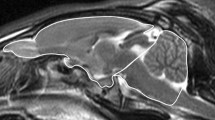Abstract
Purpose
The suprapineal recess (SPR) is a small, backward extension of the third ventricle. Few radiological studies have investigated the morphology of the SPR. Here, we explore the SPR with magnetic resonance (MR) imaging.
Methods
A total of 124 patients underwent thin-slice MR imaging examinations with T2-weighted imaging and the constructive interference steady-state (CISS) sequence. Imaging data were transferred to a workstation for analysis.
Results
The pineal gland (P) was delineated in 99% of the patients on T2-weighted imaging and 100% of the patients on the CISS sequence. In contrast, the SPR was identified in 27% of the patients on T2-weighted imaging and 82% of the patients on the CISS sequence. The location of the P relative to the lowest point of the splenium was roughly classified into two types. Of them, the anterior P location was the more frequent type and observed in 73% of the patients. The angle formed by the roof and floor of the SPR showed remarkable interindividual diversity. A membranous posterior extension with variable length, spanning between the posterosuperior margin of the P and Galenic complex was found in 55% of the identified SPRs on T2-weighted imaging and 45% on the CISS sequence.
Conclusions
The SPR is a distinct structure with diversity in appearance among individuals but commonly extends posterior to the P. High-resolution MR imaging is useful for delineating the SPR in vivo.




Similar content being viewed by others
References
Azzi C, Giaconia MB, Lacalm A, Massoud M, Gaucherand P, Guibaud L (2014) Dilatation of the supra-pineal recess on prenatal imaging: early clue for obstructive ventriculomegaly downstream of the third ventricle. Prenat Diagn 34:394–401
Barkovich AJ, Latel-Hajnal B, Partridge JC, Sola A, Ferriero DM (1997) MR contrast enhancement of the normal neonatal brain. AJNR Am J Neuroradiol 18:1713–1717
Burmeister HP, Möslein C, Bitter T, Fröber R, Herrmann H, Baltzer PA, Gudziol H, Dietzel M, Guntinas-Lichius O, Kaiser WA (2011) In vitro comparison of water displacement method and 3 Tesla MRI for MR-volumetry of the olfactory bulb: which sequence is appropriate? Acad Radiol 18:1233–1240
Cavallo LM, Di Somma A, De Notaris M, Prats-Galino A, Aydin S, Catapano G, Solari D, de Divitiis O, Somma T, Cappabianca P (2015) Extended endoscopic endonasal approach to the third ventricle: multimodal anatomical study with surgical implications. World Neurosurg 84:267–278
Daniel RT, Lee GY, Reilly PL (2004) Suprapineal recess: an alternate site for third ventriculostomy? Case report. J Neurosurg 101:518–520
Hansen PE, Ballesteros MC, Soila K, Garcia L, Howard JM (1993) MR imaging of the developing human brain. Part 1. Pineal development. Radiographics 13:21–36
Held P, Fellner C, Fellner F, Seitz J, Graf S, Hilbert M, Strutz J (1997) MRI of inner ear and facial nerve pathology using 3D MP-RAGE and 3D CISS sequences. Br J Radiol 70:558–566
Horsburgh A, Massoud TF (2013) The circumventricular organs of the brain: conspicuity on clinical 3T MRI and a review of functional anatomy. Surg Radiol Anat 35:343–349
Idris Z, Johnson JR, Abdullah JM (2015) Endoscopic fenestration at the splenial-habenular junctional area for symptomatic cavum and tumor at the foramen of Monro: case reports and anatomical review. J Neurosurg 122:504–510
Inoue Y, Saiwai S, Miyamoto T, Katsuyama J (1994) Enhanced high-resolution sagittal MRI of normal pineal glands. J Comput Assist Tomogr 18:182–186
Korf HW, Oksche A, Ekström P, Gery I, Zigler JS Jr, Klein DC (1986) Pinealocyte projections into the mammalian brain revealed with S-antigen antiserum. Science 231:735–737
Longatti P, Perin A, Rizzo V, Comai S, Bertazzo A, Allegri G (2004) Endoscopic selective sampling of human ventricular CSF: a new perspective. Minim Invasive Neurosurg 47:350–354
Longatti P, Perin A, Rizzo V, Comai S, Giusti P, Costa CV (2007) Ventricular cerebrospinal fluid melatonin concentrations investigated with an endoscopic technique. J Pineal Res 42:113–118
Plets C (1969) The arterial blood supply and angioarchitecture of the posterior wall of the third ventricle. Acta Neurochir (Wien) 21:309–317
Qi ST, Zhang XA, Fan J, Huang GL, Pan J, Qiu BH (2011) Anatomical study of the arachnoid envelope over the pineal region. Neurosurgery 68(1 Suppl Operative):7–15
Reiter RJ, Tan DX, Kim SJ, Cruz MH (2014) Delivery of pineal melatonin to the brain and SCN: role of canaliculi, cerebrospinal fluid, tanycytes and Virchow–Robin perivascular spaces. Brain Struct Funct 219:1873–1887
Rhoton Al Jr (2002) The lateral and third ventricles. Neurosurgery 51(4 Suppl):S207–S271
Schmidt F, Penka B, Trauner M, Reinsperger L, Ranner G, Ebner F, Waldhauser F (1995) Lack of pineal growth during childhood. J Clin Endocrinol Metab 80:1221–1225
Sumida M, Barkovich AJ, Newton TH (1996) Development of the pineal gland: measurement with MRI. AJNR Am J Neuroradiol 17:233–236
Sun B, Wang D, Tang Y, Fan L, Lin H, Yu T, Qi H, Li Z, Liu S (2009) The pineal volume: a three-dimensional volumetric study in healthy adults using 3.0 T MR data. Int J Dev Neurosci 27:655–660
Sun B, Tang YC, Fan LZ, Lin XT, Li ZP, Qi HT, Liu SW (2008) The pineal region: thin sectional anatomy with MR correlation in the coronal plane. Surg Radiol Anat 30:575–582
Tricoire H, Locatelli A, Chemineau P, Malpaux B (2002) Melatonin enters the cerebrospinal fluid through the pineal recess. Endocrinology 143:84–90
Acknowledgements
This work did not receive any grant.
Author information
Authors and Affiliations
Corresponding author
Ethics declarations
Conflict of interest
The authors have no conflict of interest concerning the materials or methods in this study or the findings specified in this paper.
Additional information
Satoshi Tsutsumi, Hideo Ono, and Yukimasa Yasumoto contributed equally to the study.
Rights and permissions
About this article
Cite this article
Tsutsumi, S., Ono, H. & Yasumoto, Y. The suprapineal recess of the third ventricle: an anatomic study with magnetic resonance imaging. Surg Radiol Anat 39, 725–730 (2017). https://doi.org/10.1007/s00276-016-1794-7
Received:
Accepted:
Published:
Issue Date:
DOI: https://doi.org/10.1007/s00276-016-1794-7




